Review: Encore Performing Arts Found Its Grail with MONTY PYTHON'S SPAMALOT at Dr. Phillips Center
Encore Performing Arts has a long and varied history of selecting projects for their appeal to the audience, both within the immediacy of the moment, as well as in the endurance it will hold in the memory for years to come.
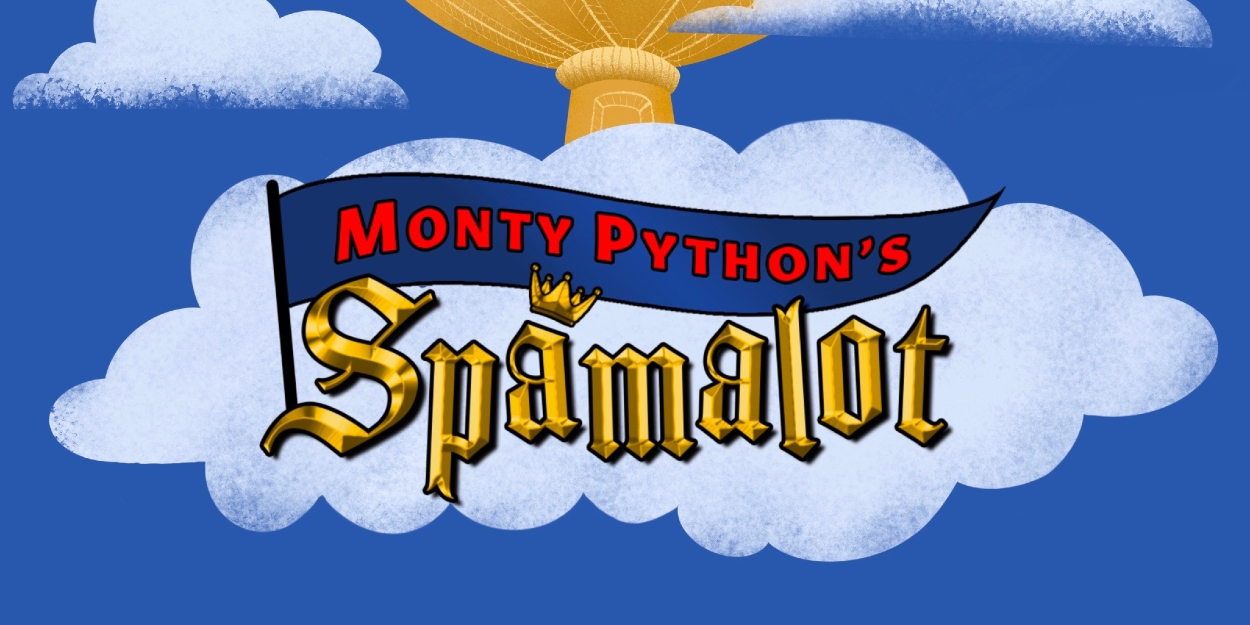
And now, for something completely similar to what you saw in a movie theatre back in 1975, but with more songs and diversity and inclusion and a better ending than – oh, get on with it.
The story of Camelot has seen various adaptations and iterations through the years. Whether it be T.H. White novel or the 1953 MGM ‘Scope epic or even Disney’s own 1963 animated adaption, the lure of King Arthur has mystified audiences for over a thousand years. Notably on the Broadway stage, two very different musicals look at Arthurian legend through vasty different lenses: one romantic, the other comedic. One of them grapples with the honor of the Round Table and the duty to one’s king, while the other can’t afford horses so they use coconuts to imitate the clip-clop sound of their shoes. One has been revived four times on Broadway, most recently by Aaron Sorkin. And the other had its own movie adaptation canceled because a couple grumpy old men said they didn’t want one. Perhaps, most importantly, one puts me to sleep any time I try to listen to its cast recording, while the other has me singing along goofily in my car every six months.
Lerner & Loewe’s CAMELOT and Monty Python’s SPAMALOT could not be any more different, yet they are still cut from the same cloth. I doubt Geoffrey of Monmouth expected his (mostly discredited fictional) tome History of The Kings Of Britain to ever yield such a wide array of retellings, especially as he intended the work to be historical fact. Yet the mythology of King Arthur, the lure of Camelot, the glory of his Knights, has outlived any historical credence. And if The Man Who Shot Liberty Valance taught us anything, it’s that when legend becomes fact, print the legend.
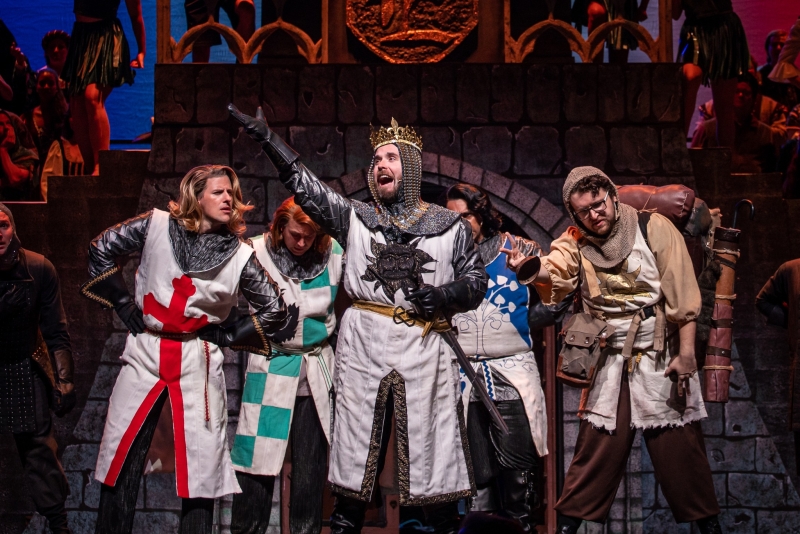
Chances are you’ve already seen SPAMALOT in a lesser form thanks to its own source: 1975’s Monty Python and the Holy Grail. I don’t mean “lesser” form as any denigration of the film, rather, as acknowledgement that SPAMALOT takes its source material and draws new meaning to it, finding improvements in some of the clunkier parts, and upping the ante in terms of how absurd the story can get. The Broadway musical enjoyed a healthy four year run before embarking on two national tours. Since then, numerous regional theatres have mounted their own production. And for one fortuitous weekend in Orlando Florida, Encore Performing Arts has the opportunity to put their own, distinctive stamp on this story.
The story begins with a stuffy Historian (Michael Angelini, Jr. in the first of many roles) introducing the audience to the story’s setting. Although he makes a point to tell the audience this is England, the opening number celebrates all things Finland (“Fisch Schlapping Song”). As the Historian corrects the slap-happy singers, we now find ourselves in England in the days of the Black Plague. King Arthur (Chase Williams) has been traveling throughout the land with his trusty manservant Patsy (Bryan Jager) in the hopes of finding men brave enough to join his Knights of the Round Table. Ultimately, he recruits four men to join him: Sir Robin (Adam Paul), Sir Lancelot (Cameron Matthews), Sir Bedevere (Nicholas McCartney), and Sir Galahad, or Dennis (Stephen White), the lattermost who needs convincing. Arthur prays to the Lady of the Lake (Neydi Jimenez), who appears to Galahad (“Come with Me”), then sings a ridiculous duet with otherwise no relevance to the story (“The Song That Goes Like This”).
Arthur brings his Knights to Camelot, which looks more like the Excalibur Hotel & Casino rather than a mythical kingdom, as the Knights delight in slots and showgirls and a headlining residency by Lady of the Lake. Although King Arthur has gathered his knights, they have no other purpose except to eat, drink, and be merry in Camelot. The Voice of God (Eric Idle) interrupts their revelry with a quest: to find the Holy Grail. Sir Galahad has his hesitations, asking why God needs a cup. (“What does God need with a starship?” Captain James T. Kirk would also say in Star Trek V.) But they are inspired to go on this quest thanks to Lady of the Lake and her motivational “Find Your Grail.” As they search throughout Europe for an artifact more likely to be found somewhere in the Middle East, their first stop is a French castle populated by haughty soldiers and walking stereotypes. Despite Sir Bedevere’s plan to use a Trojan Rabbit to infiltrate the castle, King Arthur and his Knights instead “Run Away!” and scatter to the four winds to better find the Grail.
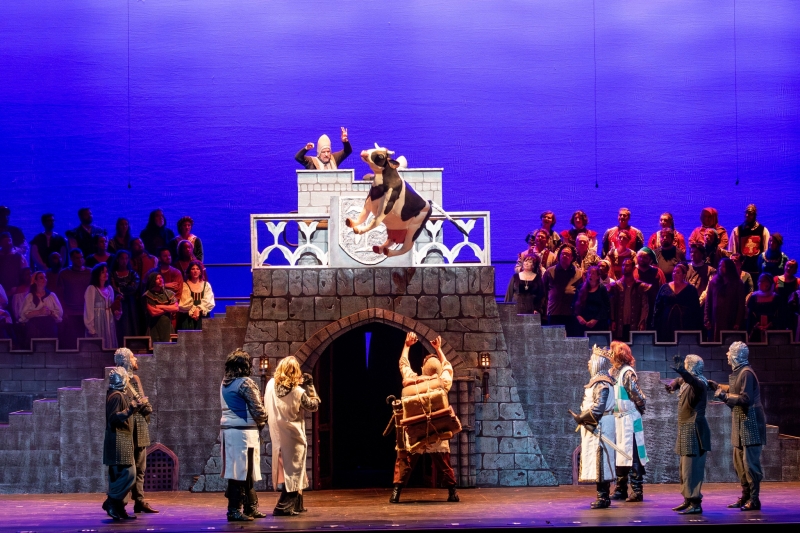
As Act Two begins, each Knight finds their own adventure amidst the quest to find the Grail. King Arthur and Patsy encounter the Knights Who Say Ni, and must acquire a shrubbery to appease them. Sir Robin runs away from every chance at danger (“Brave Sir Robin”), including a Black Knight whom Arthur later encounters. Sir Lancelot seeks to find the messenger behind a lovestruck plea for help from another kingdom, only to learn it’s a Prince unwilling to marry a Princess (“His Name is Lancelot”). And Sir Galahad kind of disappears from Act Two until the end. Lady of the Lake almost meets that same fate too, but storms onto the stage at the midpoint to muse “Whatever Happened to My Part?” a.k.a. “The Diva’s Lament.” Arthur and his Knights reunite in order to face off Tim the Enchanter and his killer rabbit. Eventually, what’s left of the plot gets solved as – spoiler alert – they find the Grail after all, although it was never as important as the friends they made along the way.
I don’t mind saying it, but Act Two is a bit of a mess compared to the solid set-up found in Act One. Putting the Knights on separate paths and generally losing any sense of plot makes the second half of this musical one we endure rather than enjoy, even though it does come with its share of great songs and gags. Yet it nearly makes SPAMALOT overstay its welcome, if only slightly, because we’re all just waiting for them to get on with it.
Even with my own issues to its narrative structure, SPAMALOT succeeds in plussing its source material in ways perhaps beyond the intention of show creators Eric Idle and John Du Prez. They’re working with a very recognizable book, as Monty Python and the Holy Grail offers an insane amount of quotable dialogue exchanges. Yet it’s in the songs and reframed character arcs that we see improvement. Lady of the Lake’s “Find Your Grail” offers a deeper understanding of how to mine pathos from comedy. When you really break it down as Sir Galahad did, a noble quest for the Holy Grail is literally just a bunch of folks looking for an old cup. (Sorry, Indiana Jones.) It’s absurd to a certain degree, and audiences delight in how silly it seems for these characters to place such importance on said cup. Still, you can’t deny these characters the meaning they find in this Grail. Within the straightforward motivational lyrics, we also see a message for the audience that’s not so reliant on the silliness of this story. Rather, it’s a song that uses the Grail as metaphor for every challenge we will face in life, for every hardship we endure, for every goal we wish to reach. We look for Holy Grails every day of our lives, we simply don’t have the advantage of a Lady of the Lake to keep encouraging us to find it.
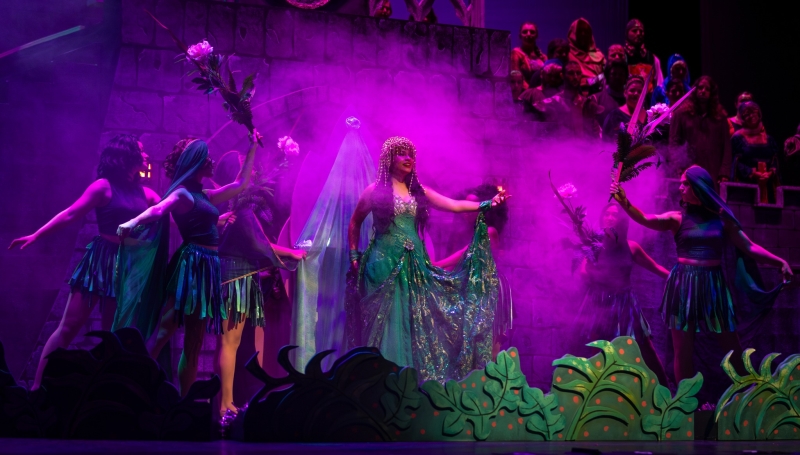
Likewise, when SPAMALOT reuses “Always Look on the Bright Side of Life,” it does so by turning the pathos of King Arthur’s plight into comedy. “Always…” was originally written as the end of Monty Python’s Life of Brian; if you’ve not seen that film I’ll not spoil how it’s used. Whereas “Find Your Grail” has a hidden meaning to draw a tear (I’ll be honest, I teared up as I really listened to the lyrics last night), “Always Look on the Bright Side of Life” invites a smile at the most dour of situations. Patsy sings it to Arthur in order to cheer him up, so we get lost in the playfulness of its performance and the fun of its lyrics. Yet, narratively, we have to remember that Arthur is separated from his Knights, with no way of finding his Grail, and no prospect of ever being more than a blip in history. In the world of that stage, he’s going through some existential crisis. As the outside observers, we allow ourselves to laugh and enjoy the production number because we know – I hope – it all turns out right in the end. The Yin and the Yang of both numbers makes them the highlight of each act, simply because they play off of the opposite emotions they normally elicit from the audience.
Finally, the most apparent change between Monty Python and the Holy Grail and SPAMALOT occurs with the characterization of Lancelot. The name itself always evokes that heroic, masculine quality that has made him a popular fictional character. But SPAMALOT posits that perhaps this character could be queer. Such a suggestion is only hinted at in previous adaptions (The Once and Future King and The Mists of Avalon). Yet in SPAMALOT, this re-characterization is openly played for laughs as Lancelot goes from this gruff and violent straight man into a camp-gay hands-on-his-hips flashy dresser. It may seem that such a change is just for shock value, but there is still a very serious intent behind it. SPAMALOT contributes and supports the notion that a fictional character, even through an LGBTQ lens, can still be true to their ideals.
Lancelot still possesses all the qualities that have kept him a heroic and admirable figure in Arthurian legend, but all that’s now changed is his sexuality. Even though the show plays to the camp, it follows the very rules of adaptation by inviting other perspectives, alternative views, and outright suggestion that Lancelot could be anything more than heteronormative. That’s not to say SPAMALOT is the first fictional work to do this, but bear in mind that within this post-SPAMALOT world, we’ve already seen the BBC queerbait audiences for five seasons of their television show “Merlin” thanks in part to an acknowledged bromance between leads Colin Morgan (Merlin) and Bradley James (Prince Arthur). Perhaps a future edition of Lerner & Loewe’s Camelot may change the affair that destroyed the dynasty into one of a Knight and his King.

Even amidst all these changes and slight improvements, it would still be very easy for someone to label SPAMALOT as a lazy cash-grab tie-in to one of the funniest movies of all time. But that would be unfair to these changes and improvements. And I genuinely don’t believe the adaptation to be lazy or cash-grabbing. SPAMALOT knows who its audience is with the Broadway stage, so appeals to their sensibilities while inviting Python acolytes and others to consider a different voice than the one they’ve known and loved for decades. And in offering an alternative take on an already-alternative take on legend, it’s enriching the material through interpretations that don’t require fidelity to what came before, but rather an honesty to the changing world it’s now in.
Python member Eric Idle was the driving force behind the show, mostly due to the disinterest from the other, surviving members of the troupe. Indeed, reactions from the rest of the troupe were mixed when the show first premiered. The two Terrys (Gilliam and Jones) and Michael Palin offered some backhanded compliments that ultimately agreed they benefited financially from the new show. John Cleese was mostly positive, gladly lending his voice of God to the original Broadway show. Graham Chapman, having passed away in 1989, could not be reached for comment.
All this is to ask, is SPAMALOT better than Monty Python and the Holy Grail? Even though I’m more favorable to SPAMALOT and have outright said so in my review, it would be unfair to the intent of both productions to deliberately rank one over the other. They’re made for different mediums, for different needs of its audience, and for different expectations of its performers. Monty Python and the Holy Grail is still a crowning achievement within Python humor and British cinema. It led to the (far superior) Monty Python’s Life of Brian and cemented the comic genius of the entire troupe. But it’s locked in time, forever more, to that period between seasons of a sketch comedy show in the mid 1970s. SPAMALOT, by sheer virtue of being recontextualized for a stage with reaction from a live audience, will keep changing. It will keep updating itself to stay relevant, while still keeping the core of its story and of its message readily available for the audience yesterday, the audience today, and the audience tomorrow.

Encore Performing Arts has a long and varied history of selecting projects for their appeal to the audience, both within the immediacy of the moment, as well as in the endurance it will hold in the memory for years to come. Their slate of shows have continually invited the audience to keep coming back and see what they’ve got in store, and for performers and volunteers to give their time and talent with no expectation beyond the gratefulness of that audience. It’s a symbiotic relationship of generosity that has always put me in awe of every production.
The last time Encore Performing Arts mounted a show at the Walt Disney Theatre, Hairspray was all the rage. The scope and scale of that production is once more matched, and perhaps exceeded, with SPAMALOT. It’s a crowd-pleaser that brings back the same audience that made Hairspray such a success in this same space six years ago. However, the size of the theatre is never as important as the talent of the cast. I’ve seen some fairly disappointing touring shows at Dr. Phillips Center, countered with truly stellar Encore shows in much smaller venues elsewhere. Regardless the size of the stage, the talent that inhabit it is what makes a performance so memorable. I’d just as soon watch Encore perform summer stock in a barnyard as if they were an old Judy Garland and Mickey Rooney musical, and I’d still enjoy it. Still, there’s a sense of homecoming with SPAMALOT bringing Encore back to the Walt Disney Theatre. All that talent on a stage could dominate anywhere as proven by their productions at The Abbey, at Orlando Shakes, at Osceola Arts. They’ve earned their loyal audience on talent alone, so it’s very rewarding to see them back where they belong on that Walt Disney Theatre stage.
At the helm is the reliable Michael Rodgers, who’s been Encore’s regular director for years, having last directed February’s Sordid Lives. He’s gathered together a stable of performers both new and old to Encore. Chief among them was the choir, dominating rows upon rows of platforms in our medieval world. I could recognize quite a few familiar faces from past Encore shows, but also welcomed all the new singers I heard that night.

Chief among the principles is lead actor Chase Williams as King Arthur. Williams has worked on various shows with other Central Florida theatres, but makes his Encore debut her. His turn in the role comes with a lot of exciting ad-libs and remarkable chemistry with not just Neydi Jimenez (Lady of the Lake), but also Bryan Jager (Patsy). All three are new to Encore and I hope to see more contributions from them in future shows. Also new to the Encore family are Nicholas McCarthey and Sean Murphy. McCarthey pulls double duty as both Sir Bedevere and Dennis’ Mother, the latter role of which puts him in the same camp as Terry Jones in the 1975 original film. Murphy, originally a pinch-hitter for Patsy, took on the role of Sir Bors in addition to his other roles throughout the night including a snooty French guard, a book-thwonking Monk, and Sir Not Appearing In This Show. With the last character’s literal five seconds of stage time, he garnered as much laughs as the rest of the company for a joke that always delights in how absurd it is.
Much of King Arthur’s knights are played by a stable of Encore veterans as we saw Cameron Matthews as Sir Lancelot, Adam Paul as Sir Robin, and Stephen White as Sir Galahad. Matthews’s depiction of Lancelot – even with the camp characterization – never feels like it’s making fun of the newfound character trait. And his comic timing opposite Stephen White (when pulling double duty as Prince Herbert’s father) and Michael Angelini (as Prince Herbert) feels very much like a classic Hollywood screwball comedy come to life on the stage. Adam Paul’s Sir Robin gets the short shrift because his character is so cowardly, but he absolutely dominates “You Won’t Succeed on Broadway” and all the various Broadway musicals it riffs (chiefly Fiddler on the Roof, but also classics like Annie and Chicago as well as new hits like Dear Evan Hansen and Six). It was certainly the high point of Act Two’s meandering plot.
Honestly, at this point, I would be surprised to go to an Encore show and not see Michael Angelini, Jr. in a role. Angelini wears no less than six different hats here, inhibiting a variety of characters that feel uniquely different to the other: the snooty Historian, the even snootier French guard, Not-Dead Fred, a judgmental minstrel, and the effeminate Prince Herbert, not to mention a dance solo as a Dancing Monk opposite Marissa Hebson’s Dancing Nun. He pulls from all different mindsets and disciplines for each character and it shows. The way the Minstrel ponces about is different from when Prince Herbert floats across the stage. When Not-Dead Fred does a jig, it’s more sporadic and playful compared to the classiness of the Dancing Monk.
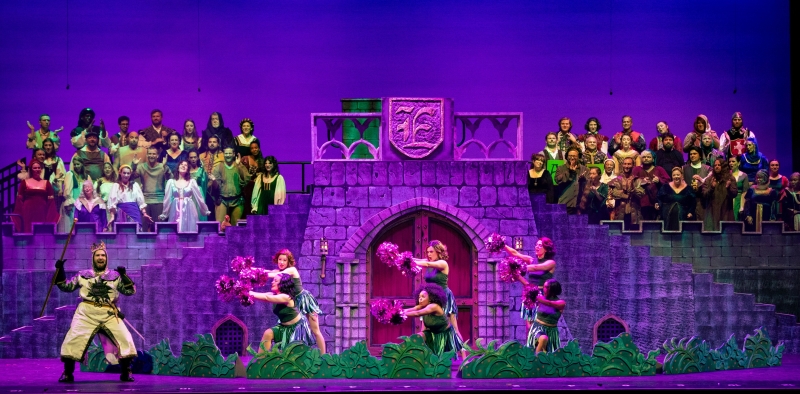
Also making a grand return is the full Encore choir, dominating rows upon rows of platforms behind the castle. Everyone’s clad in medieval garb that turn them into the full populace of Camelot, of France, of Pride Month, etc. I even saw some audience members Spamalot-bounding with like-minded Ren Fair costumes. In a fun change from previous Encore choirs, for SPAMALOT they’re given a variety of props to use throughout various numbers. The props range from rubber chickens to hymnals to spectator signs to even a variety of Mickey Mouse ears. I loved seeing every new prop for the choir, along with the variety of costumes, as past shows tended to use them as one singular choir to amplify the voices. The use of them in SPAMALOT as well as the extras helped them fill out the stage while also integrating them more beyond their traditional choir role.
The “Dark and VERY Expensive Forest” is designed by Encore mainstay Cliff Price (peek him in the left side of the choir, too!), Michael Hirsch, and Ty Menard. They’ve made a multi-purpose castle and other stage props transport us throughout all of England, while a very clever rolling canvas allows us to venture beyond Europe itself. Likewise, the lighting design by Holly Wheldon Carpenter plays around with the colorful motifs of each Knight throughout their own adventures. Most memorably, it washes the entire stage in a bright hue of the color purple when Lady of the Lake and Arthur reunite. Whether or not that was an intentional nod to Alice Walker’s The Color Purple, I don’t know, but then again, I’ve always kept that quote (“I think it pisses God off if you walk by the color purple in a field somewhere and don’t notice it”) very close to my heart and choose to read it as such.
SPAMALOT signals a return to form for Encore Performing Arts. The past few years have seen a variety of shows mounted all throughout Central Florida. But coming back to Dr. Phillips Center tonight signalled, at least for me, a return to a pre-covid normalcy. One of the first things I did when I moved from New Jersey to Florida was scope out the local theatre scene to decide which venues would get my patronage. A chance encounter of Encore’s Aida in 2015 has led to a now-eight-year commitment to seeing their shows. It’s not about the theatre, I eventually realized, but about the people that make that theatre come alive. Encore Performing Arts has always been among the best in Central Florida for that very reason.

People come and go from our lives all the time. Shows have an ending, a song will reach its final measure. But the stories told keep going, passed down generationally and changed, improved, amended to new sensibilities. It’s the storytellers’ responsibility to ensure that a story is worth telling, or re-telling, or rewriting entirely from the ground up. So much of what I love about SPAMALOT is that faithfulness to an iconic film, but also its willingness to see the opportunity for change. Likewise, with every Encore production, there’s always a faithfulness to the audience. They know what we will like, and they know exactly who the right storytellers are to share the story with us. But they’re not afraid to take risks, to change or emphasize as well. Because we need that room to grow, to not become complacent.
I’ve called SPAMALOT a homecoming for Encore, because of the familiarity and the comfort of seeing such a beloved theatrical production company back in their element. But it’s just as much a fun challenge to see the new talent they invite on that stage every year, along with the sheer delight of seeing the familiar faces crop up time and again. SPAMALOT may be limited to two nights at Dr. Phillips Center, but Encore will be here for the long haul.
MONTY PYTHON’S SPAMALOT plays only this weekend, July 8 and 9, at Dr. Phillips Center. Tickets can be acquired online or at the box office, pending availability. Pictures by Tiffany Bagwell Photography & Black Hat Photography, used with permission.
Reader Reviews

Videos

